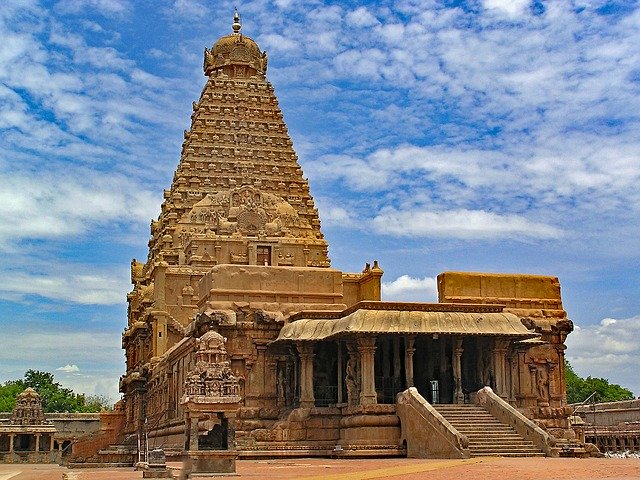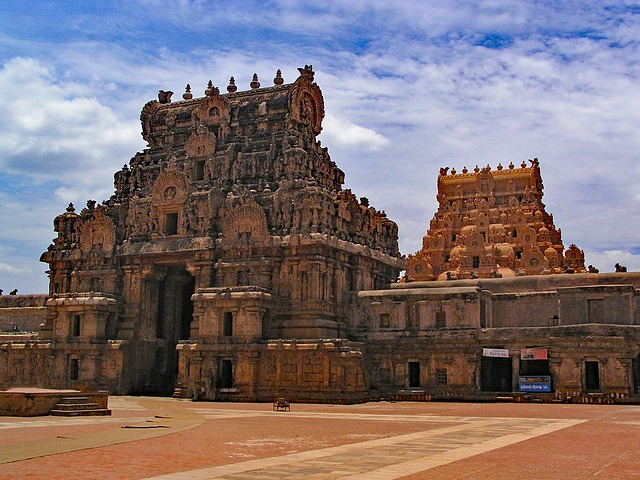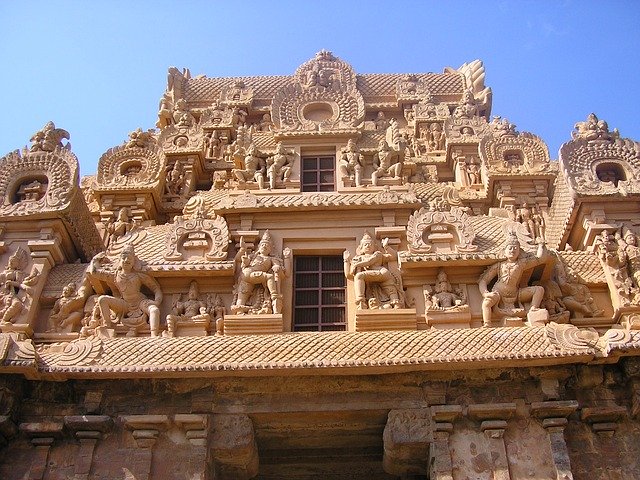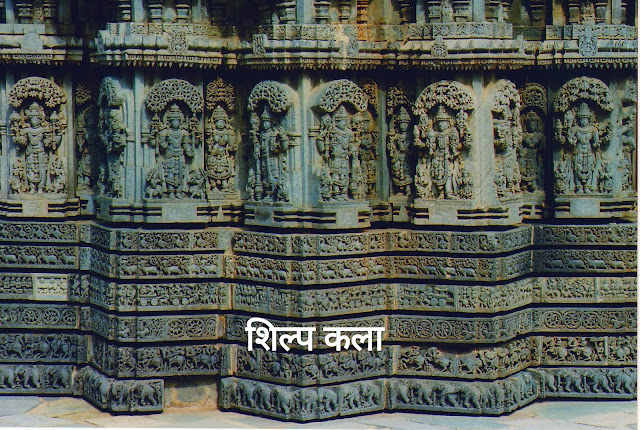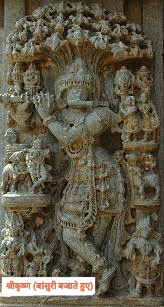मैसूर पैलेस / Maisur Pales
मैसूर शहर के केंद्र में स्थित मैसूर पैलेस को अम्बा विलास पैलेस के नाम से भी जाना जाता है। यह पैलेस मैसूर का सबसे प्रमुख पर्यटन स्थल है जो साल में लाखों पर्यटकों को आकर्षित करता है। चामुंडा पहाड़ियों के सम्मुख पुराने किले के भीतर स्थित यह ऐतिहासिक महल वाडियार राजवंश के आधिकारिक निवास के रूप में खड़ा है, जिसने 1399 से 1950 तक मैसूर राज्य पर शासन किया था।
 |
| Maisur Pales (मैसूर पैलेस) |
इतिहास / History of Maisur Pales
1399 में वाडियार वंश की स्थापना करने वाले यदुराया वाडियार के साथ शुरुआत करते हुए, यादवों ने छह शताब्दियों तक इस क्षेत्र पर शासन किया। १४ वीं शताब्दी में यदुराया वाडियार महाराज ने पहली बार मैसूर के पुराने किले के भीतर एक महल का निर्माण करवाया जो कि बाद में कई बार ध्वस्त कर पुनः स्थापित किया गया। मई 1799 में टीपू सुल्तान की मृत्यु के तुरंत बाद, महाराजा कृष्णराज वाडियार तृतीय ने मैसूर को अपनी राजधानी बनाया और अंततः अंग्रेजों के नियंत्रण में आ गए।
1897 में महामहिम राजर्षि कृष्णराज वाडियार चतुर्थ की सबसे बड़ी बहन, राजकुमारी जयलक्ष्मी का विवाह समारोह में लगी आग से लकड़ी का महल लगभग नष्ट हो गया था। उसी वर्ष मैसूर के राजा, महामहिम महारानी वाणी विलास संनिधना के युवा सम्राट और उनकी मां ने ब्रिटिश वास्तुकार लॉर्ड हेनरी इरविन को एक नया महल बनाने के लिए सौंप दिया। 1912 में 4147913 रुपये की लागत से महल का निर्माण पूरा हुआ जिसका विस्तार 1940 में मैसूर साम्राज्य के अंतिम महाराजा जयचामाराजेंद्र वाडियार के शासन में किया गया था।
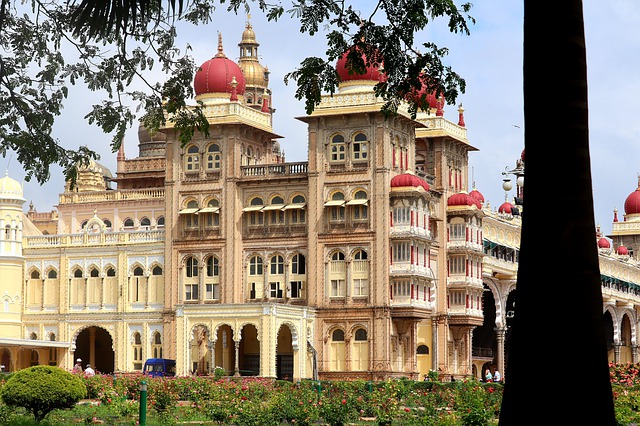 |
| Maisur Pales (मैसूर पैलेस) |
स्थापत्य कला
महल तीन मंजिला पत्थर की संरचना है, जो कि महिन ग्रेनाइट से बनी है, जो भूरे रंग की है, जिसके ऊपर गहरे गुलाबी रंग के संगमरमर के पत्थर लगे हैं और एक पाँच मंजिला मीनार है जिसकी ऊँचाई 145 फीट है। महल का आकार 245 फीट से 156 फीट है। गुंबद 19 वीं सदी के अंत में ब्रिटिश भारत में ब्रिटिश वास्तुकारों द्वारा लागू किए गए इंडो-सारासेनिक वास्तुकला को चित्रित करते हैं। इसमें भारतीय, इंडो-इस्लामिक, नियो-क्लासिकल और गोथिक पुनरुद्धार शैलियों के तत्व शामिल हैं। परिसर के तीन द्वार महल तक ले जाते हैं - सामने का द्वार (विशेष रूप से पूर्वी द्वार) वीवीआईपी के लिए और अन्यथा दशहरा के दौरान खुलता है; दक्षिण गेट को आम जनता के लिए नामित किया गया है; और पश्चिम द्वार आम तौर पर दशहरा में खुला रहता है। इनके अलावा महल के तहखाने में कई गुप्त सुरंगें हैं जो कई गोपनीय क्षेत्रों और श्रीरंगपटना शहर जैसे अन्य स्थानों की ओर ले जाती हैं। कई फैंसी मेहराब इमारत के अग्रभाग को दो छोटे मेहराबों से सुशोभित करते हैं जो मध्य एक के दोनों तरफ लंबे स्तंभों के साथ समर्थित हैं। सौभाग्य, समृद्धि और धन की देवी गजलक्ष्मी की एक मूर्ति, जिसमें उनके हाथी हैं, केंद्रीय मेहराब के ऊपर बैठी हैं। चामुंडी हिल्स के सामने स्थित महल देवी चामुंडी के प्रति मैसूर के महाराजाओं की भक्ति का प्रकटीकरण है। मैसूर साम्राज्य का हथियार और कोट प्रवेश द्वार और मेहराब को सुशोभित करता है। महल के चारों ओर एक बड़ा, सुंदर और सुव्यवस्थित उद्यान स्थल को और भी शानदार बनाता है।
 |
| Maisur Pales (मैसूर पैलेस) |
आकर्षण एवं सौंदर्य
मैसूर पैलेस, मैसूर साम्राज्य के प्रसिद्ध वाडियार महाराजा का राजमहल आज राष्ट्र की कीमती संपत्ति में से एक है, जिसे वर्तमान में एक संग्रहालय में बदल दिया गया है। हड़ताली अलंकृत और बारीक छेनी वाले दरवाजे समृद्ध और सुरुचिपूर्ण ढंग से अलंकृत कमरों तक ले जाते हैं। बाहरी रूप से स्तंभित दरबार हॉल, ठोस चांदी के दरवाजे, महीन उठी हुई महोगनी छतें और महल के कई अन्य अलंकरण रोल्स की शानदार जीवन शैली का विचार देते हुए एक मंत्रमुग्ध कर देते हैं। महल के प्रदर्शनों में शाही पोशाक, स्मृति चिन्ह, संगीत वाद्ययंत्र और वाडियारों द्वारा इस्तेमाल किए जाने वाले हथियार शामिल हैं। शानदार चित्रों की एक श्रृंखला जिसमें देवी शक्ति की 8 अभिव्यक्तियों को दर्शाया गया है, साथ ही प्रसिद्ध कलाकार राजा रवि वर्मा द्वारा महल में एक उत्कृष्ट कृति भी मिलती है।
 |
| Maisur Pales (मैसूर पैलेस) |
उत्सव
प्रसिद्ध मैसूर दशहरा त्योहार हर साल शरद ऋतु के दौरान महल में मनाया जाता है। त्यौहार के 10 दिनों के दौरान शाम 7 बजे से रात 10 बजे तक लगभग 100,000 प्रकाश बल्बों से महल रोशन रहता है। त्यौहार के दौरान चिन्नदा सिम्हासन या रत्न सिम्हासन जो कि शाही सिंहासन है, इसकी सोने की प्लेटों पर आकर्षक डिजाइनों से सजाया गया है। इस दौरान महल में विभिन्न धार्मिक और सांस्कृतिक कार्यक्रम किए जाते हैं। महानवमी के शुभ दिन यानी 9 वें दिन, ‘पट्टदा कट्टी' (शाही तलवार) की पूजा करने के बाद इसे ऊंटों और हाथियों के साथ जुलूस में ले जाया जाता है। 10 वें दिन या विजयदशमी पर पारंपरिक दशहरा जुलूस बड़े धूमधाम और उत्साह के साथ महल से निकलता है, जिसका मुख्य आकर्षण देवी चामुंडेश्वरी की मूर्ति है, जो लगभग 750 किलो सोने से बने एक सुनहरे मंडप पर विराजमान है।
14 वीं शताब्दी से 1953 तक विभिन्न समय में बने महल में 12 हिंदू मंदिर हैं। इनमें सोमेश्वर मंदिर और लक्ष्मीरामन शामिल हैं।
साउंड एंड लाइट शो
रविवार और सार्वजनिक अवकाश को छोड़कर सभी दिनों में साउंड एंड लाइट शो का आयोजन शाम 7:00 बजे से शाम 7:40 बजे तक किया जाता है। शो के लिए प्रवेश शुल्क वयस्कों के लिए ₹ 40, 7 से 12 वर्ष की आयु के बच्चों के लिए ₹ 25 और विदेशी नागरिकों के लिए ₹ 200 रुपए है। यह महल रविवार शाम 7 बजे से शाम 7.45 बजे तक, राज्य त्योहारों और राष्ट्रीय अवकाशों पर और अन्य दिनों में 7.40 बजे से शाम 7.45 बजे तक साउंड और लाइट शो के बाद रोशन रहता है।
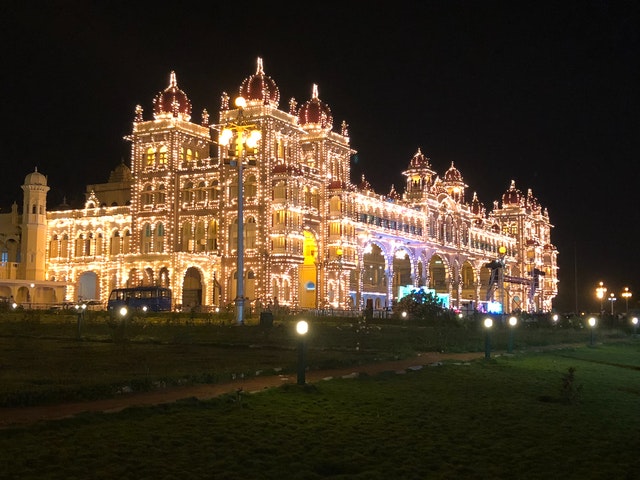 |
| Maisur Pales (मैसूर पैलेस) |
_________________ _________________ _________________ _________________ _________________
English Version
मैसूर पैलेस / Maisur Pales
The
Maisur Pales situated in the center of Mysore city is also known as
Amba Vilas Palace. This palace is the most prominent
tourist place to visit in India of
Maisur Pales which attracts millions of tourists a year. Situated within the old fort in front of the Chamunda Hills, this historic palace stands as the official residence of the Wadiyar dynasty, which ruled the
Maisur Pales state from 1399 to 1950.
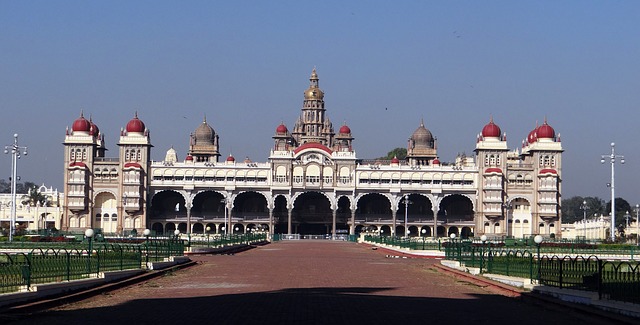 |
| Mysore Palace (मैसूर पैलेस) |
इतिहास / History of Maisur Pales
Beginning with Yaduraya Wadiyar, who founded the Wadiyar dynasty in 1399, the Yadavas ruled the region for six centuries. In the 16th century, Yaduraya Wadiyar Maharaj built a palace within the old fort of Maisur Pales for the first time which was later demolished and re-established. Soon after the death of Tipu Sultan in May 1799, Maharaja Krishnaraja Wadiyar III made Maisur Pales his capital and eventually came under the control of the British.
In 1897, the wooden palace of His Majesty Rajarshi Krishnaraja Wadiyar IV's eldest sister, Princess Jayalakshmi, was almost destroyed by the fire in the wedding ceremony. In the same year the young emperor of His Majesty Queen Vani Vilas Sanidhana, the King of Maisur Pales and his mother, handed over the British architect Lord Henry Irwin to build a new palace. The construction of the palace was completed in 1912 at a cost of Rs 4147913 which was expanded in 1940 under the rule of Jayachamarajendra Wadiyar, the last Maharaja of the Kingdom of Mysore.
 |
| Mysore Palace (मैसूर पैलेस) |
Architecture of Maisur Pales
The Maisur Pales is a three-storied stone structure, made of mahine granite, brown in color, covered with dark pink marble stones and a five-storeyed tower measuring 145 feet in height. The size of the palace is 245 feet to 156 feet. The domes depict Indo-Saracenic architecture implemented by British architects in British India in the late 19th century. It contains elements of Indian, Indo-Islamic, Neo-classical and Gothic revival styles. The three gates of the complex lead to the palace - the front gate (especially the eastern gate) to VVIP and otherwise open during Dussehra; The South Gate is designated for the general public; And the west gate is usually open in Dussehra. Apart from these, there are several secret tunnels in the basement of the Maisur Pales which lead to many secret areas and other places like Srirangapatna town. Many fancy arches beautify the façade of the building with two small arches supported by tall columns on either side of the middle one. An idol of Gajalakshmi, the goddess of good fortune, prosperity and wealth, holding her elephants, sits atop the central arch. The palace in front of the Chamundi Hills is a manifestation of the devotion of the Maharajas of Mysore to the goddess Chamundi. The arms and coats of the Kingdom of Mysore adorn the entrances and arches. A large, beautiful and well-maintained garden around the palace makes the site even more spectacular.
 |
| Mysore Palace (मैसूर पैलेस) |
Attractions and Beauty in Maisur Pales
The Maisur Pales, the palace of the famous Wadiyar Maharaja of the Kingdom of Mysore, is today one of the precious assets of the nation, which is currently converted into a museum. Striking ornate and finely chiselled doors lead to rich and elegantly ornate rooms. The externally pillared Durbar Hall, solid silver doors, fine mahogany ceilings and many other adornments of the palace give an enchantment giving an idea of the luxurious lifestyle of the Rolls. The palace displays include royal attire, souvenirs, musical instruments and weapons used by the wadiyars. A series of magnificent paintings depicting 8 manifestations of Goddess Shakti, along with a masterpiece by the famous artist Raja Ravi Varma are found in the palace.
 |
| Mysore Palace (मैसूर पैलेस) |
Festivals in Maisur Pales
The famous Maisur Pales Dussehra festival is celebrated every year in the Maisur Pales during the autumn. The palace is illuminated by around 100,000 light bulbs from 7 pm to 10 pm during the 10 days of the festival. The Chinnada Simhasan or Ratna Simhasan which is the royal throne during the festival is decorated with attractive designs on its gold plates. During this time various religious and cultural programs are performed in the palace. After worshiping 'Pattada Katti' (royal sword) on the auspicious day of Mahanavami i.e. 9th day, it is taken in procession with camels and elephants. The traditional Dussehra procession on the 10th day or Vijayadashami leaves the palace with great pomp and fervor, the main attraction of which is the idol of Goddess Chamundeshwari, which sits on a golden pavilion made of about 750 kg gold.
There are 12 Hindu temples to visit in Mysore in the Maisur Pales built at various times from the 14th century to 1953. These include Someshwar Temple and Lakshmiraman.
Sound and light show in Maisur Pales
Sound and light shows are held from 7:00 pm to 7:40 pm on all days except Sundays and public holidays. The entry fee for the show is ₹ 40 for adults, ₹ 25 for children aged 7 to 12 and ₹ 200 for foreign nationals. The palace is illuminated on Sundays from 7 pm to 7.45 pm, on state festivals and national holidays and on other days from 7.40 pm to 7.45 pm after sound and light shows.
 |
| Mysore Palace (मैसूर पैलेस) |
Maisur Pales is the best tourist places in India to visit.





